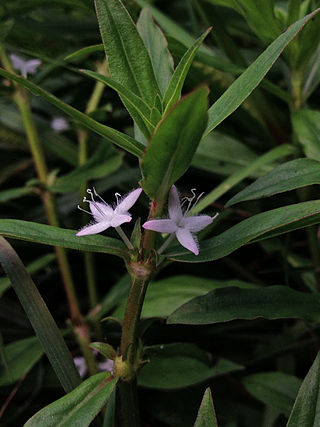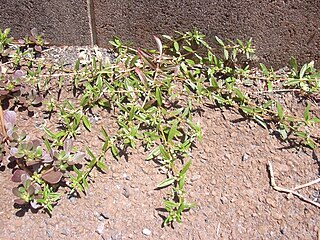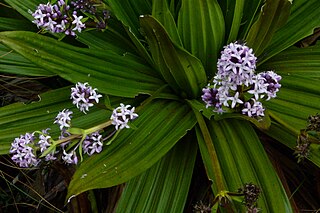
Diodia is a genus of flowering plants in the family Rubiaceae. It was described by Carl Linnaeus in 1753. The genus is found from southern and eastern United States, South America, Central America, Mexico, the West Indies and tropical Africa.

Xylophanes tersa, the tersa sphinx, is a moth of the family Sphingidae. The species was first described by Carl Linnaeus in 1771. It is found from the United States, through Mexico, the West Indies and Central America and into parts of South America. An occasional stray can be found as far north as Canada.

Oldenlandiopsis (creeping-bluet) is a genus of flowering plants in the family Rubiaceae. It is monospecific, comprising only one species, Oldenlandiopsis callitrichoides. This species had previously been placed in Hedyotis or in Oldenlandia. It is native to the West Indies, southern Mexico, and Central America. It is naturalized elsewhere, including Florida, Hawaii, South America, and tropical Africa.

Houstonia (bluet) is a genus of plants in the family Rubiaceae. Many species were formerly classified, along with other genera since segregated elsewhere, in a more inclusive genus Hedyotis.

Oldenlandia is a genus of flowering plants in the family Rubiaceae. It is pantropical in distribution and has about 240 species. The type species for the genus is Oldenlandia corymbosa.
Hedyotis (starviolet) is a genus of flowering plants in the family Rubiaceae. Many species of this genus such as Hedyotis biflora, H. corymbosa and H. diffusa are well known medicinal plants. Hedyotis is native to tropical and subtropical Asia and to islands of the northwest Pacific. It comprises about 115 species. The type species for the genus is Hedyotis fruticosa.

Kadua is a genus of flowering plants in the family Rubiaceae. It comprises 29 species, all restricted to Polynesia. Twenty-two of these are endemic to the Hawaiian Islands. Some of the species are common at high elevation. Others are single-island endemics or very rare, and a few are probably extinct. Kadua affinis is widely distributed in Hawaii and is polymorphic. The type species for the genus is Kadua acuminata.
Amphistemon is a genus of 2 species of flowering plants in the family Rubiaceae. It is described by Inge Groeninckx in 2010 based on a molecular analysis of the Hedyotis-Oldenlandia group. The genus name is based on the Greek 'amphi-' and 'stemon' (=stamen) referring to the dimorphic stamen position characteristic for this genus.

Arcytophyllum is a genus of flowering plants in the family Rubiaceae. The genus contains 18 species, distributed from New Mexico to Bolivia.

Hedyotis verticillaris is a plant belonging to the family Rubiaceae that is endemic to the higher altitude grasslands of the Nilgiris in southern India. Unlike many others members of the genus the stems of this species are underground and the leaves appear close to the ground forming rosettes and usually hold some water at the centre of the whorl of leaves. The flowers are produced on a stalk.
Carterella is a monotypic genus of flowering plants in the family Rubiaceae. The genus contains only one species, viz. Carterella alexanderae, which is endemic to Baja California Sur in Mexico. It grows on steep slopes in the mountains.
Houstonia ouachitana, the Ouachita bluet, is a species of plants in the coffee family. It is endemic to the Ouachita Mountains of Arkansas and Oklahoma. It is an herb up to 20 cm tall, with lanceloate basal leaves and narrowly linear cauline leaves.
Houstonia acerosa, the New Mexico bluet or needleleaf bluet, is a plant species native to Chihuahua, Coahuila, Nuevo León, Tamaulipas, San Luis Potosí, Texas and New Mexico.
Houstonia palmeri, the Saltillo bluet, is a plant species in the family Rubiaceae, native to the Mexican states of Coahuila and Nuevo León.

Houstonia micrantha, the southern bluet, is a plant species in the coffee family.
Houstonia sharpii, the Hidalgo bluet, is a plant species in the family Rubiaceae. It is a herbaceous perennial up to 30 cm tall, spreading by means of stolons spreading along the surface of the ground. It also has white flowers. It is native to the states of Hidalgo, Puebla and Veracruz in Mexico.
Houstonia spellenbergii is a plant species in the family Rubiaceae. It is native to the western part of the state of Chihuahua in northern Mexico, at an elevation of approximately 2100 m in the Sierra Madre Occidental near the Basaseáchic waterfall.

Spermacoceae is a tribe of flowering plants in the family Rubiaceae and contains about 1346 species in 57 genera. Its representatives are found in the tropics and subtropics.

Leptopetalum is a genus of flowering plants in the family Rubiaceae. The genus is widespread in tropical and subtropical Asia and the Pacific.
Hedyotis indirae is a species of flowering plant in the coffee family Rubiaceae that is endemic to Western Ghats in India. It is a new shrubby species of Rubiaceae from Muthikulam forest of Palakkad district in Kerala.











